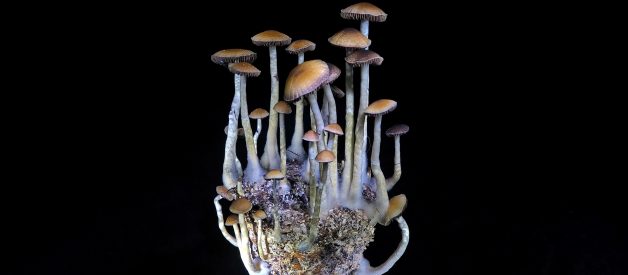Mason jars are good for just about anything.
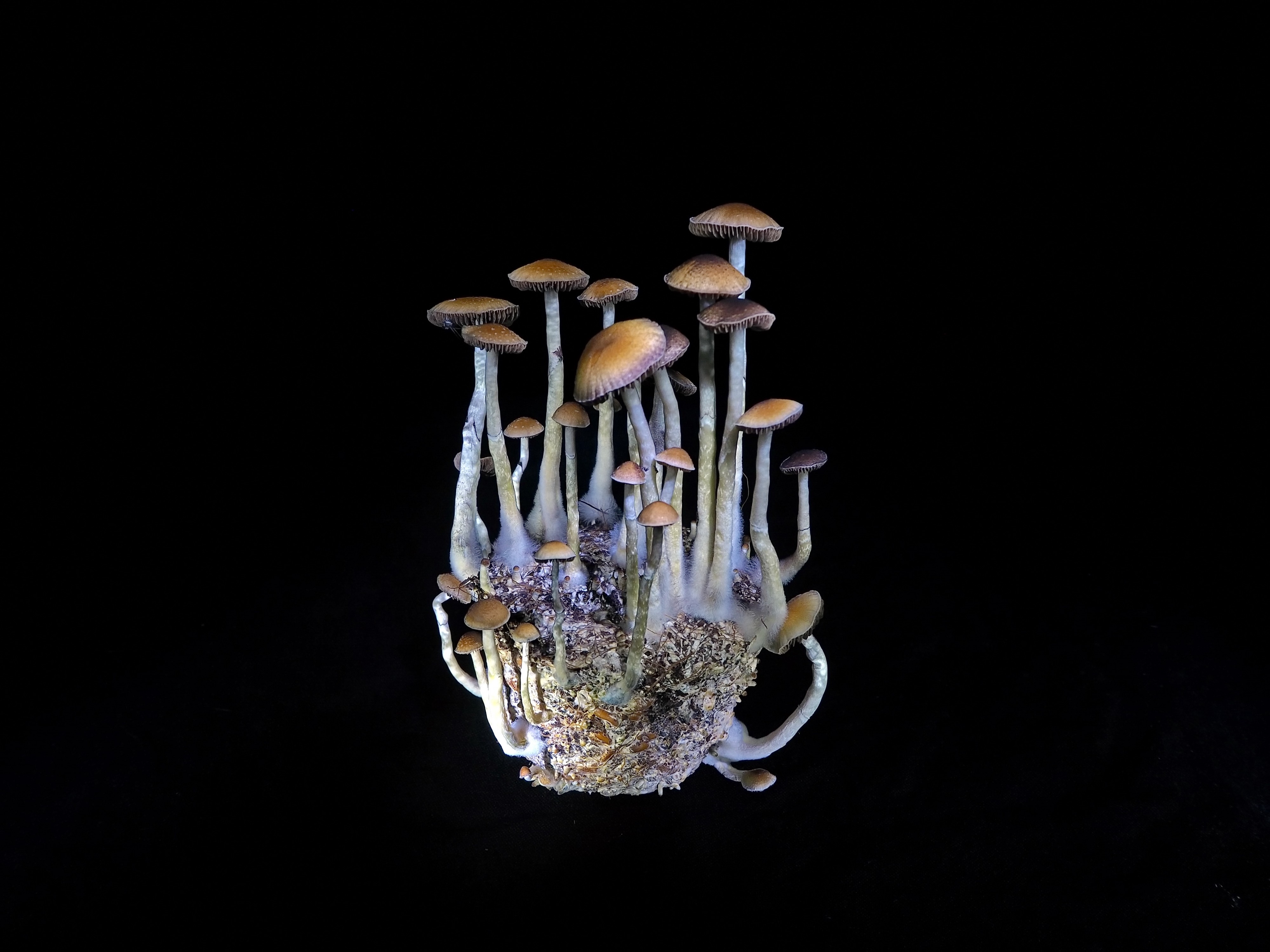
Life on Earth, as you know it, would be impossible without the humble fungi. In the beginning, fungi played an essential role in the development of our oxygen-rich atmosphere by mining phosphorous from the rocks and transferring it to plants to power photosynthesis. So, without fungi, your life as a human wouldn?t be possible.
Also, fungi decompose practically everything that dies or decays. Without fungi, death would engulf the Earth, and make it virtually uninhabitable for you and every other living organism.
And Fungi impact your life significantly in ways you?re likely unaware of, and you probably barely notice.
Fungi and Your Food
You may not know it, but fungi figure prominently in your diet. Mushrooms are the fleshy, spore-producing, fruiting body of fungi. Typically, mushrooms grow above ground and are but a minute portion of the larger organism that grows below ground, weaving its way through the soil and among the roots of plants.
No doubt you already know you can eat mushrooms and you should since they have a plethora of health benefits.
Morels, shiitake, chanterelles, and truffles are considered delicacies. But mushrooms aren?t the only way fungi appear in your diet. Molds of the genus Penicillium ripen many kinds of cheese.
Fungi also ferment the grains and fruit to produce the beer and wine you drink, and they provide the wild yeast for bread.
Saccharomyces cerevisiae, also known as baker?s yeast, is an essential ingredient in natural sourdough bread making, a food that?s been a staple of human life for thousands of years.
Fungi and Your Health
Mushrooms fight cancer
A study in the Journal of Experimental Biology and Medicine found that all the common mushroom varieties reduced breast cancer cells by a whopping 33 percent. But breast cancer isn?t the only type of cancer mushrooms help. Studies on prostate and stomach cancer show similar results.
They?re immune-boosting and high in vitamins
Beta-glucan and lentinan are two properties found in mushrooms that give your immune system a much-needed boost. Plus, they?re high in crucial vitamins ? many mushroom varieties contain high levels of vitamin D, and crimini mushrooms carry lots of B12, which makes them an excellent choice for vegetarians since B12 is most common in animal products.
Fungi as Medicine
Red yeast rice is the earliest medicinal use of fungi on record. China developed it around 800 AD. Cultivating Monascus purpura (yeast) in rice produces a pharmaceutically active mixture of compounds.
Now, millions of patients with life-threatening diseases are treated each year with medicines made from fungi. The medicinal value of fungal metabolites is a knowledge that?s centuries old.
Perhaps the most potent yet controversial fungal medicine is psilocybin mushrooms, medicinal properties have also been used for centuries.
In his book, ?How to Change Your Mind: What the New Science of Psychedelics Teaches Us About Consciousness, Dying, Addiction, Depression, and Transcendence,? Michael Pollan delves deep into the history of these drugs.
Pollan explains that psychedelics were once legal and used successfully in the US to treat mental disorders, including anxiety, depression, and addiction. According to Pollan, ?For most of the 1950s and early 1960s, many in the psychiatric establishment regarded LSD and psilocybin as miracle drugs.?
How They Work
Hallucinogens alter your perception, mood, and a slew of other mental processes by working their magic on your brain?s cortex. The drugs activate specific receptors called 5-HT2A receptors (2ARs) that are typically triggered by serotonin.
This cascade of neurobiological changes to your brain helps you to experience a renewed wonder at everyday things. You?ll have greater self-awareness. Your senses will be more acute so that colors appear more vibrant and sound, taste, and smell more intense. And you?ll remain focused on the present.
The positive effects remain long after the drugs have left the building. Participants reported a significant reduction in anxiety and depression after just one use.
They also mentioned experiencing a ?spiritual awakening,? which was responsible for a permanent shift in their consciousness. Afterward, participants said it was easier to stay focused on the present, and they had a greater awareness of the interconnectedness of all things.
So, if you suffer from any of the aforementioned mental diseases, or you want to experience spiritual enlightenment and quiet the constant chatter in your mind, psilocybin mushrooms may be for you. And you may be wondering how to cultivate them.
Grow Em
So, now that you know the extensive benefits of fungi and their mushrooms, are you ready to grow some? The following technique works for most types of mushrooms, but the focus of this article is on psilocybin cultivation.
Currently, it?s illegal to cultivate psilocybin mushrooms in most countries. But, right now, medical researchers are working diligently to prove the therapeutic efficacy of psychedelic drugs like psilocybin, and they?ll likely be legal soon. So, you can learn the process for when they become legal. Because you, of course, wouldn?t dream of breaking the law, right?
At this point, you?re probably wondering how long this process takes. That?s a terrific question. Here?s an approximate timeline:
- Spore inoculation to spore germination ? within a week
- Spore germination to complete colonization of the cake ? about 2 to 4 weeks.
- Start of fruiting cycle ? approx two weeks.
After two or so, the cakes will begin to turn blue, and no more mushrooms will form.
All in all, the process takes from 4?6 weeks from spore inoculation to fruiting.
Here?s what you?ll need:
Phase one ?
- 10 Sterilized inoculation jars with a substrate. Or one jar for each cc in your syringe. You can also make inoculation jars with wide-mouth mason jars and brown rice flour or another substrate. But, you?ll need to follow an intense sterilization process.
- Latex gloves
- Paper towels
- A face mask (and thanks to COVID 19, you probably already have one of these)
- Rubbing alcohol
- A syringe of mushroom spores (spore syringes are available on the internet. There are some states like California, Oregon, and Georgia to which most places won?t ship. However, I did find one reliable source for those as well.
- Hypodermic needles that are the correct size for your syringe. (if your syringe didn?t come with them.
- A lighter
- A can of disinfectant spray (like Lysol)
Phase two ?
- A spray bottle
- A fruiting chamber ? i.e., clear plastic tub with a lid
- Drill four or five 1/2 inch holes on either side of your growing box so air can circulate.
- A spot that receives plenty of indirect sunlight
- Temperature and humidity gauge
- Vermiculite (Some growers suggest Perlite. There is a difference between the two.)
- 3-percent hydrogen peroxide
There are four crucial aspects you?ll need to get right to reap a reward for your efforts, and they are:
- Hygiene
- Humidity
- Light
- Temperature
You?ll learn about each of these as we go through the steps. So, here goes:
Phase One
Phase one of your cultivation is where you?ll create what?s known as a birthing cake. A birthing cake is when mycelium has fully colonized your jar and wound around the substrate. When you turn it out of the mason jar, it will hold together like a cake and sprout mushrooms.
Step One: Sterilize
Enemy number one in mushroom cultivation is harmful bacteria hijacking your inoculation jars. That?s why you?re going to take the following steps to sterilize the jars and the surrounding environment. You?re trying to keep minuscule microbes from creating murderous mayhem on your spores and multiplying in your jars.
Choose a small room in your house, like a bathroom that you can use as your secret laboratory (prep space).
Gather all the items on the phase one portion of your list. Don your face mask, enter the room and close the door.
Spray the room down reasonably well with the disinfectant spray. Then put on your gloves.
Wipe your jars off with rubbing alcohol using paper towels. Pay special attention to the top of the jar.
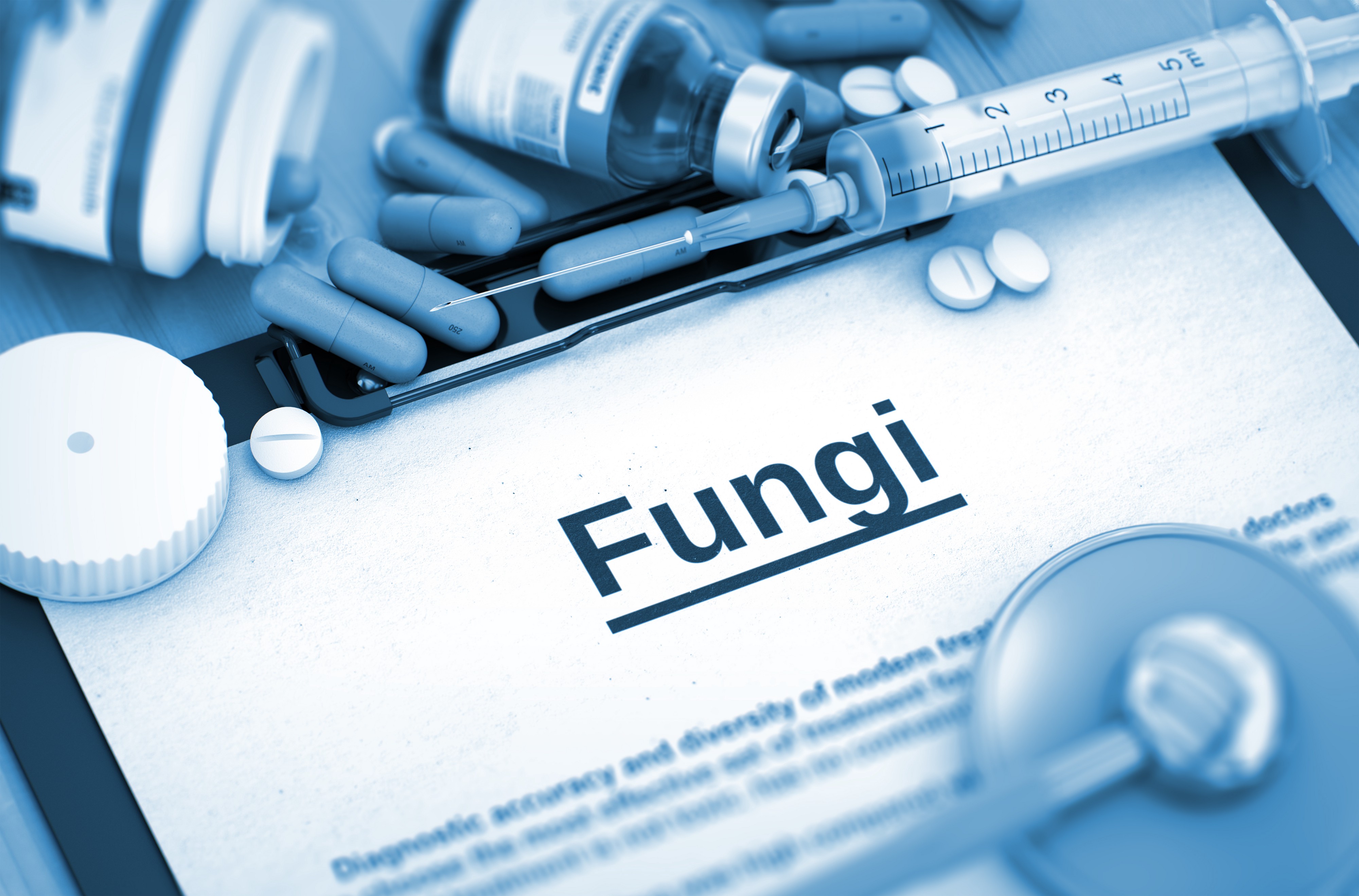
Step Two ? Inoculate
Use your lighter and heat the metal portion of your hypodermic needle until it glows red. Typically hypodermic needles come pre-sterilized, so this is merely a precaution.
After you sterilize the needle, don?t lay it down, continue to hold it until the needle cools down.
Shake your syringe to distribute the spores evenly. Insert the needle into the port and inject one cc into the jar.
Repeat with the remaining jars, sterilize your needle each time.
Step Three ? Wait
After injection, place your jars in a cardboard box, close the lid, and put it in a dark, warm place. You?ll want a steady temp of 80 to 85 degrees Fahrenheit. I know it?s exciting, but try not to check your jars for five days. They need the dark.
After five days or so, a fuzzy, white substance will start to form in your jars. When this happens, jump up and down and perform a joyful, happy dance because this is a good sign.
The white substance you see is mycelium. Mycelium is the vegetative part of the fungus, similar to the roots of a plant. And the mushroom is like the flower on the plant.
Let the mycelium grow for at least 15 days, and it can take much longer. Once your jars are 100-percent colonized by mycelium, wait a week then proceed to phase two.
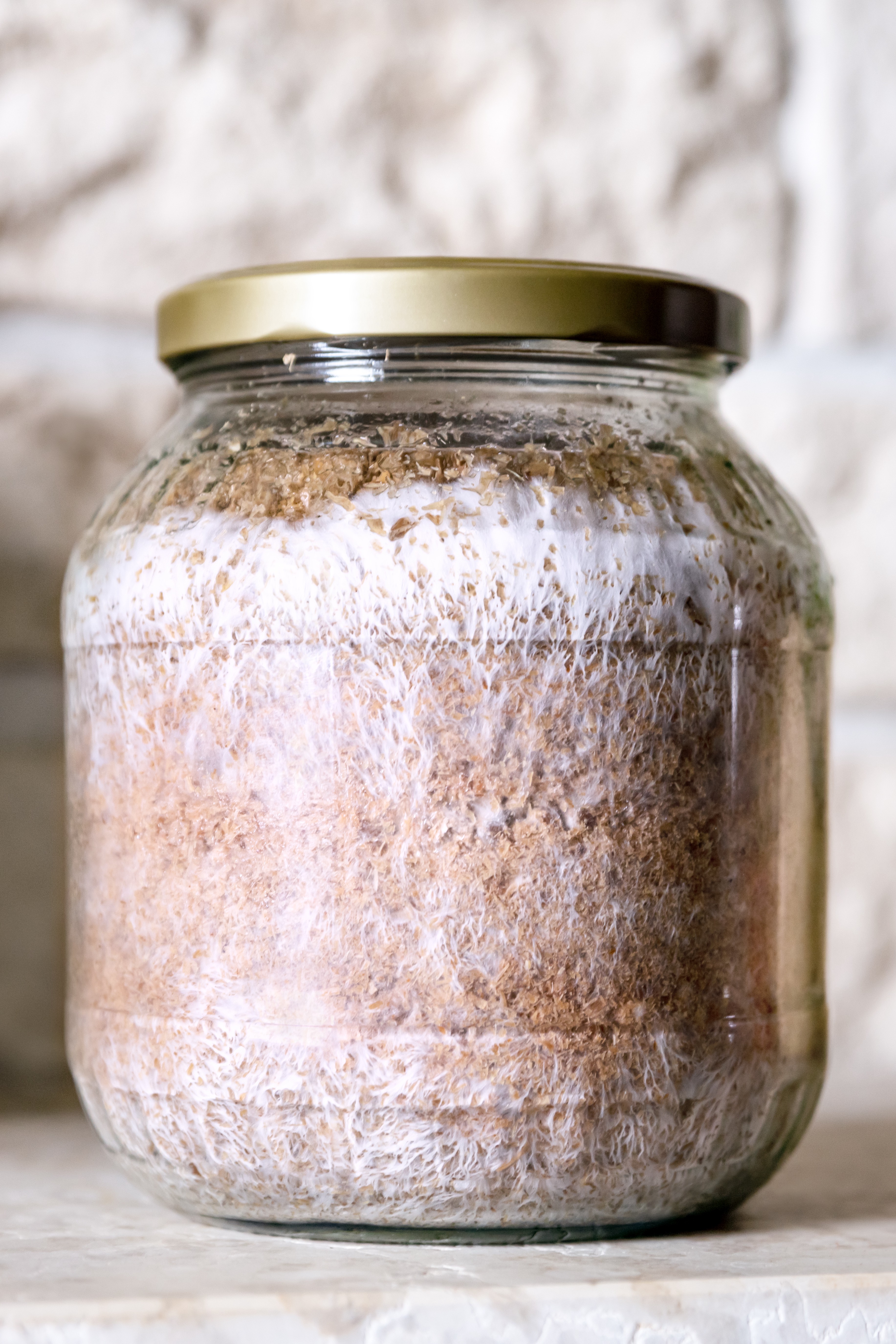 A jar fully colonized by mycelium
A jar fully colonized by mycelium
Phase Two
Now it?s time to remove the birthing cakes from their jars. Over the next month, they?ll sprout mushrooms ? hopefully, a whole plethora of them.
First, gather your jars and all the items on the list for phase two.
Step One ? Birth and soak your mycelium cakes
Once your jars are fully colonized by mycelium, it?s time to birth them and place them in the fruiting chamber so they can sprout mushrooms. But, the mycelium have been in an airtight container and have used all the moisture in the jars. They?re going to be thirsty, so you?re going to give them a nice soak for 12 to 24 hours before you place them in their new home.
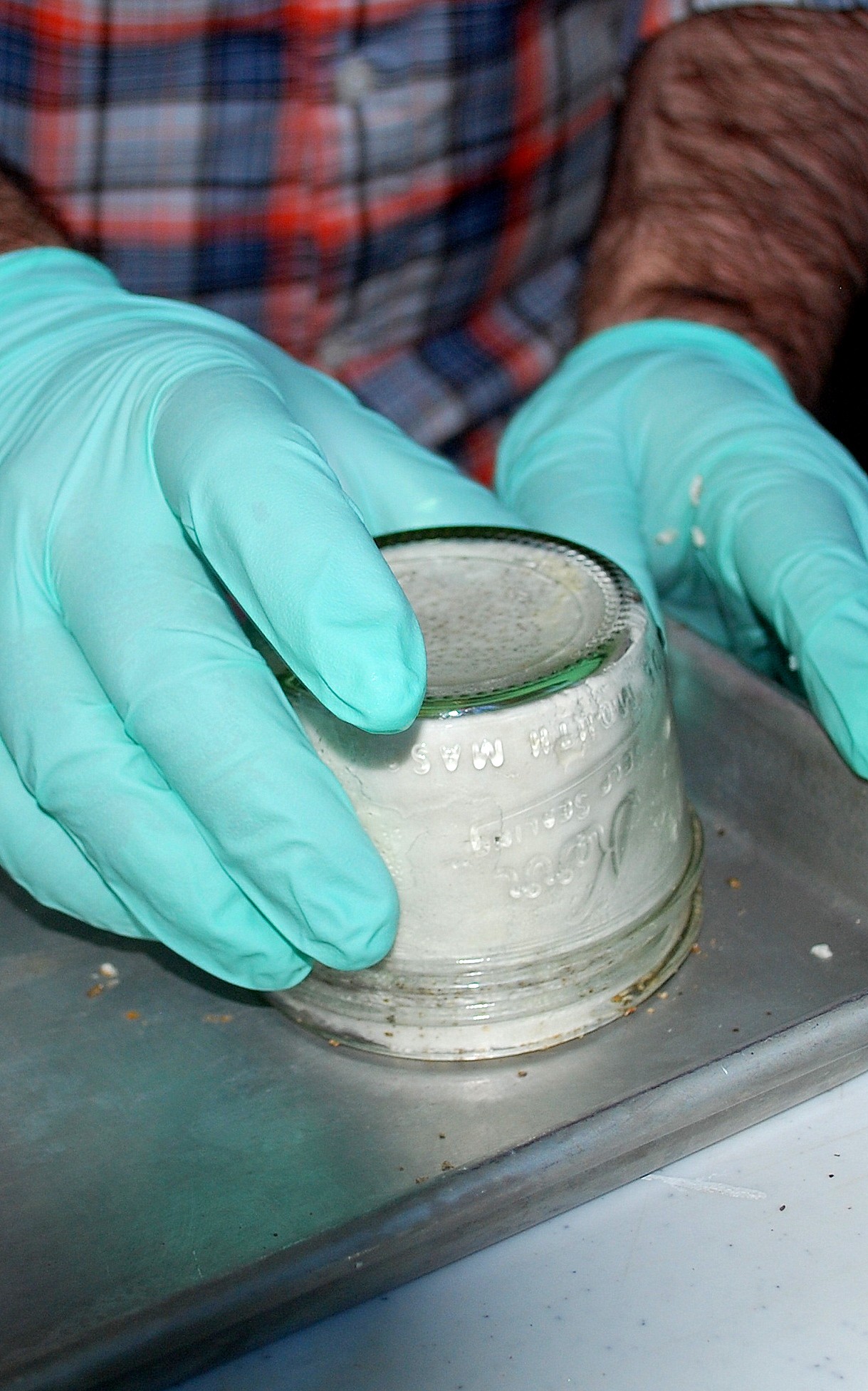 Birthing a cake ? Image credit Everything Mushrooms
Birthing a cake ? Image credit Everything Mushrooms
- Have large plastic baggies, or a sterilized plastic container with lid and some filtered water ready.
- Put on clean gloves or wash your hands ? thoroughly.
- Loosen the lids of your jars. Discard the band, you?ll use the flat tops later on.
- Bang a jar against your hand to release the cake. (It may take a bit of banging and shaking to get the cake out of the jar. That?s ok. Just touch the cake as little as possible).
- Place the cake into the baggie or container and do the same with the remaining cakes. (Your cakes are pretty durable once they?re fully colonized with mycelium, so they?re not going to fall apart or break.)
- Fill the baggies or container as full as possible with filtered water and seal them up. The cakes are going to float, so if you?re using baggies you?ll need to remove as much air as possible.
- Put your cakes in your refrigerator and leave them for 12 to 24 hours. I soak for 12 hours, some growers soak for 24.
After your mycelium cakes have had their long, cold bath, it?s finally time for them to go in the chamber.
Step Two? Prepare the chamber
Pour boiling water and a bit of bleach into your container and swish it around to sterilize your container. Then rinse the container with boiling water without bleach. Then clean your flat mason jars lids the same way.
Fill your spray bottle with 10 parts boiled water to one part hydrogen peroxide or H202.
Create a layer of vermiculite or Pearlite on the bottom of your growing chamber and moisten it thoroughly with your H202 infused spray bottle. But don?t soak it so much it?s sitting in water.
The vermiculite is there to help your growing chamber maintain humidity, and you will need to re-wet it periodically.
Place your mason jar lids into the bed of vermiculite, then place a cake on each lid. Sprtiz each cake thoroughly with your h20/h202 mixture, but not so much that puddles form. Make sure you leave enough room between each cake, so there?s plenty of room for mushrooms to sprout without crowding each other.
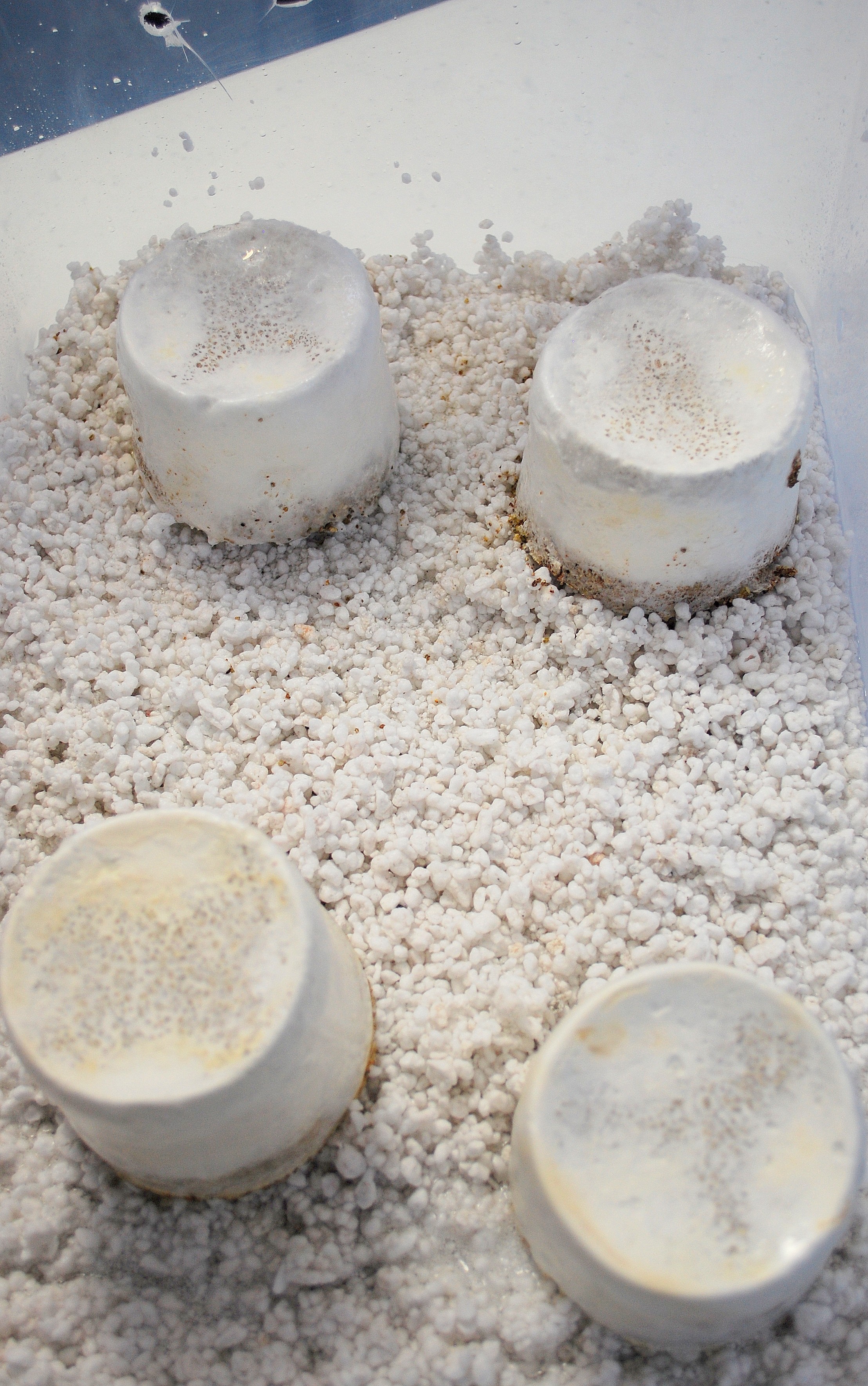 Image credit ? Everything Mushrooms
Image credit ? Everything Mushrooms
You may see little mushroom sprouts already forming, these are called pins. And that?s a good thing.
To check the health of your mycelium, give each cake a little sniff. They should smell faintly like the fresh mushrooms you buy from the store. If you smell foul odors, that a sign your mycelium may have harmful bacteria.
Step Three
Put the lid on your growing chamber and place it where it will receive indirect sunlight. The room should be well ventilated.
Maintenance
For the next month or so, mist your mushroom twice a day with the water and hydrogen peroxide mixture. Keep an eye on your humidity/temperature gauge. Ideally, you want to maintain a temperature in the mid to low 70?s and humidity of 85-percent. If your humidity level is low, you may have to spritz them more frequently.
Harvesting
When your mushrooms are ready for harvest, snap them off the birthing cake at the base of their stems and place them in an airtight container in your refrigerator.
A harvest of mushrooms is called a flush. You can reuse the cakes for multiple flushes. Since this is an article for beginners, I?m going to save those instructions for part two.
Yield, Storage, and Dosage
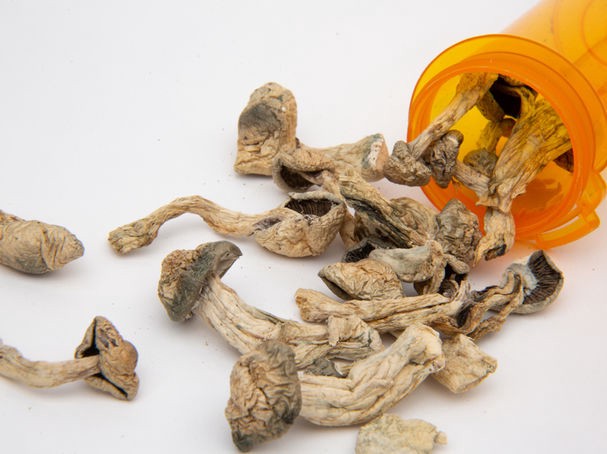
Your Yield
The primary image in this article is one of a fully ripe birthing cake that?s ready for harvest. As you can see, one cake can yield plenty of mushrooms. I recommend ten jars because that?s how many jars most syringes will innoculate.
Ten jars yield ten birthing cakes, which will produce more than a lifetimes supply for most people. You can start with fewer jars, which means you?ll have leftover spores. Spores stay viable for eight months to one year, but dried mushrooms last far longer.
Storage
Mushrooms stay fresh for 3?15 days. Keep them in the fridge as you would any mushroom. After that, dry them and place them in an airtight container. Then place the container in a cool, dark place.
Dose
There is no set dosage for psilocybin mushrooms, so your dose depends on your size, sensitivity level, and the effect you desire. And it depends on the strength of the mushrooms. One mushroom can pack a punch, so start slow. You can?t un-eat them if you take too much, but you can take more during your psychedelic journey. Just remember it can take up to an hour before you feel the effects.
Your set and setting are just as crucial as the dose you take, and there are steps you can take to ensure a positive experience.
A Final Word
Just like everything else in life, there are a gazillion methods for growing mushrooms. After you?ve grown a batch or two, you can debate all the daunting details of the perfect fungus growing process with experienced, enthusiastic experts who will, no doubt, make comments on this article. But if you?re a beginner, this is a simple method you can wrap your brain around.
Do the number of steps feel a bit daunting? If so, re-read the steps until you can picture the entire process. Once you?re familiar with the steps, they?ll seem simple.
Lastly, don?t focus on the result; enjoy the entire process. To grow anything is a privilege. But to cultivate a substance that can heal your mind and soul and transform your consciousness without adverse side effects is the mystery and magic of nature, and it deserves your appreciation.
